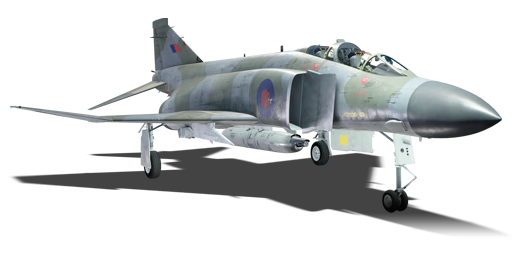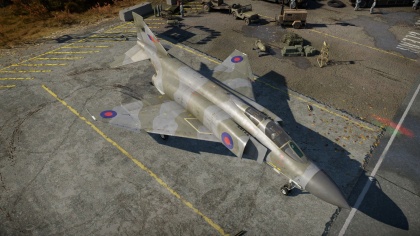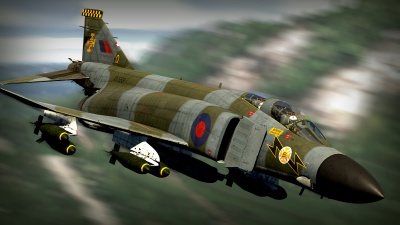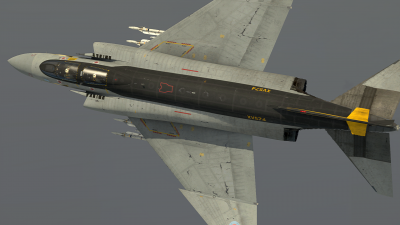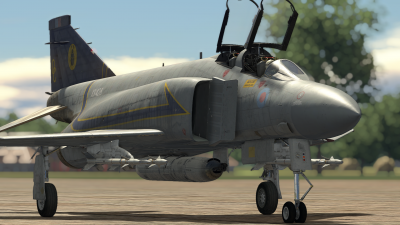Phantom FGR.2
Contents
| This page is about the British jet fighter Phantom FGR.2. For the USAF version, see F-4C Phantom II. |
Description
The Phantom FGR.2, also known as the F-4M, is a rank VII British jet fighter
with a battle rating of 11.7 (AB), 12.0 (RB), and 11.3 (SB). It was introduced in Update 1.93 "Shark Attack". It is a British version of the American F-4 Phantom II.
Although at first glance the F-4M appears very similar to its American counterpart the F-4C Phantom II, there are a number of major visual and performance differences between the two aircraft. Phantoms produced for the RAF were redesigned to use British Rolls-Royce Spey turbofan engines, instead of the General Electric J79 turbojet engines found on American Phantoms. The British engines produced more thrust than the American engines, but were larger; as a result the fuselage of British Phantoms was modified to be slightly wider than on the American models. In addition the Phantom FGR.2 has larger air intakes than the F-4C, in order to allow for the increased airflow required by the new engines. The rear of the Fuselage is also significantly different on the Phantom FGR.2; the engines are noticeably angled downwards, and due to the different afterburner arrangement on the Spey engines the exhaust ports and the surrounding area were redesigned. Most distinctively, the Phantom FGR.2 has a squared off tail, and lacks the under-nose probe of the F-4C.
In game these changes mean that the Phantom FGR.2 has much better low altitude acceleration and climb rate, compared to the F-4C, as a result of the more powerful engines. In games you will usually see the Phantom FGR.2s get off the ground and to altitude quicker than the F-4Cs; however due to the increased drag of the redesigned fuselage, and the performance characteristics of the Spey engines, it does not perform quite as well as the F-4C at high altitude, and cannot reach the same maximum speed.
General info
Flight performance
Describe how the aircraft behaves in the air. Speed, manoeuvrability, acceleration and allowable loads - these are the most important characteristics of the vehicle.
| Characteristics | Max Speed (km/h at 10,667 m) |
Max altitude (metres) |
Turn time (seconds) |
Rate of climb (metres/second) |
Take-off run (metres) | |||
|---|---|---|---|---|---|---|---|---|
| AB | RB | AB | RB | AB | RB | |||
| Stock | 2,195 | 2,158 | 16000 | 26.5 | 26.8 | 177.3 | 167.0 | 850 |
| Upgraded | 2,351 | 2,268 | 25.5 | 26.0 | 245.5 | 210.0 | ||
Details
| Features | |||||
|---|---|---|---|---|---|
| Combat flaps | Take-off flaps | Landing flaps | Air brakes | Arrestor gear | Drogue chute |
| X | ✓ | ✓ | ✓ | ✓ | ✓ |
| Limits | ||||||
|---|---|---|---|---|---|---|
| Wings (km/h) | Gear (km/h) | Flaps (km/h) | Max Static G | |||
| Combat | Take-off | Landing | + | - | ||
| N/A | 625 | 463 | ~11 | ~4 | ||
| Optimal velocities (km/h) | |||
|---|---|---|---|
| Ailerons | Rudder | Elevators | Radiator |
| < 810 | < 750 | < 700 | N/A |
Engine performance
| Engine | Aircraft mass | ||||||
|---|---|---|---|---|---|---|---|
| Engine name | Number | Empty mass | Wing loading (full fuel) | ||||
| Rolls-Royce Spey 203 | 2 | 13,900 kg | 402 kg/m2 | ||||
| Engine characteristics | Mass with fuel (no weapons load) | Max Takeoff Weight | |||||
| Weight (each) | Type | 7m fuel | 20m fuel | 26m fuel | |||
| 1,860 kg | Afterburning low-bypass turbofan | 15,507 kg | 18,427 kg | 19,775 kg | 25,400 kg | ||
| Maximum engine thrust @ 0 m (RB / SB) | Thrust to weight ratio @ 0 m (WEP) | ||||||
| Condition | 100% | WEP | 7m fuel | 20m fuel | 26m fuel | MTOW | |
| Stationary | 5,120 kgf | 9,031 kgf | 1.16 | 0.98 | 0.91 | 0.71 | |
| Optimal | 5,120 kgf (0 km/h) |
10,331 kgf (1,200 km/h) |
1.33 | 1.12 | 1.04 | 0.81 | |
Survivability and armour
Much like the older F-4C variant, the British Phantom FGR.2 is without any armour protection whatsoever - the weight savings allow the aircraft to take on more fuel or ordnance while utilising speed as its best defence. This fighter packs numerous fuel tanks, while some are located in the leading edges of the wings, the majority of the fuel tanks are located within the fuselage packed around the engines and behind the cockpit. The control lines for the Phantom FGR.2 run from the cockpit down the length of the upper fuselage to the tailplane, relatively exposed to enemy gunfire.
Fighters attempting to take down a Phantom FGR.2 should try to force it to bleed its energy in a turn with missiles - a slow Phantom is a vulnerable Phantom. Autocannons and missiles will be most effective for disabling or destroying critical components, but smaller rockets such as M/55, SNEB Type 23 or FFAR Mighty Mouse unguided rockets fired in salvos during a head-on engagement may cause enough of a scattered grouping that a Phantom FGR.2 may not be able to avoid them all and fly into at least one.
Armaments
Suspended armament
The Phantom FGR.2 can be outfitted with the following ordnance:
- 1 x 20 mm M61 cannon, belly-mounted (gunpod) (1,200 rpg)
- 1 x 20 mm M61 cannon, belly-mounted (gunpod) (1,200 rpg) + 8 x 1,000 lb G.P. Mk.I bombs (8,000 lb total)
- 1 x 20 mm M61 cannon, belly-mounted (gunpod) (1,200 rpg) + 108 x SNEB type 23 rockets
- 1 x 20 mm M61 cannon, belly-mounted (gunpod) (1,200 rpg) + 4 x AIM-9D Sidewinder missiles
- 1 x 20 mm M61 cannon, belly-mounted (gunpod) (1,200 rpg) + 4 x 1,000 lb G.P. Mk.I bombs + 4 x AIM-9D Sidewinder missiles (4,000 lb total)
- 4 x AIM-9D Sidewinder missiles
Like the F-4C the Phantom FGR.2 lacks any internal guns; instead relying on an M61 Vulcan rotary cannon, mounted centrally under the fuselage. The cannon is angled downwards at about 1°, coupled with the position of the gun under aircraft this makes aiming slightly more difficult than on other aircraft; the gun also has a wide bullet spread. A benefit of the rotary cannon is that it can fire all 1,200 rounds of ammo before it can overheat and jam. Unlike the F-4C the Phantom FGR.2 can only carry a single gunpod.
In terms of other suspended weaponry, the Phantom FGR.2 falls far behind the F-4C, having 6 loadout options compared to the F-4C's 21. It has a more limited choice of bombs, carries fewer rockets and cannot carry Bullpup air to ground missiles.
In terms of air to air missiles the Phantom FGR.2 can carry four AIM-9D Sidewinder missiles; as opposed to the F-4C's choice of AIM-9B and AIM-9E Sidewinders. The AIM-9D is very similar to the AIM-9E in some ways outperforms it; the AIM-9D can pull 16 G instead of 10 G and is faster, with a more powerful rocket motor. The AIM-9E, however, can be slaved to the Phantom's radar unlike the AIM-9D and may track better.
Usage in battles
Describe the tactics of playing in the aircraft, the features of using aircraft in a team and advice on tactics. Refrain from creating a "guide" - do not impose a single point of view, but instead, give the reader food for thought. Examine the most dangerous enemies and give recommendations on fighting them. If necessary, note the specifics of the game in different modes (AB, RB, SB).
Modules
The order in which modifications are unlocked on the Phantom FGR.2 will depend to some extent on how one would like to play the aircraft. The AIM-9D missiles are among the best available to top tier jets, and so most fans of missile combat will likely want to unlock them as soon as possible. If missiles are not desired then it may be wise to instead focus on unlocking the 20 mm belts and new 20 mm cannon modification, to make the spread of the gun less extreme and more usable; and if one plans to use it as a ground attacker, then the ordnance options are the obvious choice (although the FGR.2 does not excel in this role to the same extent as its American counterpart). When equipped with its 8 x 1,000 lb bombs the FGR.2 becomes highly potent bomber; using its low altitude performance to get to enemy bases incredibly quickly, it is possible to unlock the bombs and use this tactic to speed up unlocking other modifications, although the FGR.2 is a capable fighter when stock so this is not a necessity.
Even when stock the Phantom FGR.2 is just about the best-performing aircraft in the game at low altitude; with this in mind flight performance upgrades are not as much of a priority as on other aircraft, so weapons upgrades can be prioritised. When unlocking flight performance upgrades one may wish to focus on engine upgrades to further improve the FGR.2's incredible acceleration and climbing performance.
| Tier | Flight performance | Survivability | Weaponry | |
|---|---|---|---|---|
| I | Compressor | Fuselage repair | 1000 LB GP | |
| II | New boosters | Airframe | Offensive 20 mm | Matra SNEB |
| III | Wings repair | G-suit | AIM-9D | |
| IV | Engine | Cover | New 20 mm cannons | |
- Possible modules to prioritise (depending on play-style of the pilot)
- Powerful missiles - AIM-9D module
- Ammunition variety - Offensive 20 mm module
- Ground attack - 1,000 LB GP module for larger bombs followed up with Matra SNEB module for unguided rockets
Pros and cons
Pros:
- Better acceleration and climb rate than the F-4C
- One of the fastest aircraft in the game, especially at low altitude (just above sea level it can reach ~ Mach 1.17 when stock and ~ Mach 1.22 when spaded)
- One of the fastest climbing aircraft in the game
- Carries AIM-9D air-to-air missiles, what are mostly on par with and in some ways better than the AIM-9E found on the F-4C
- Very high rate of fire from autocannon, which does not jam
- Has tail-hook, can land on aircraft carriers
- Has a drogue chute to aid in braking upon landing
Cons:
- Gun pod is slightly angled downwards and has very wide bullet spread when stock, although this can be useful in some situations, it can make the gun hard to aim in others
- Gun pod cannot be fired while the landing gear is down
- Missiles are tier 3 upgrade modification which needs to be researched
- Large target compared to other aircraft such as the MiG-21 F-13
- Due to large weight it requires a high landing sped (~350 kph), can be tricky to land for players new to the fighter (especially on aircraft carriers)
- Not quite as good at high altitude as the F-4C
- Taking minimum fuel leaves the aircraft with very limited battle endurance (especially with use of the afterburner), while the 20 min fuel option noticeably impacts handling
- Missiles cannot be fired while pulling more than 4 G's, and when flying at high speed even gentle manoeuvres will cause exceed that limit
History
Background
From the late 1950s onwards the British Government began looking to replace a number of its early second-generation jet aircraft. The RAF was looking to replace the English Electric Canberra in the long-range interdictor role, and the Hawker Hunter in the close air support role; meanwhile the Royal Navy was looking to replace their de Havilland Sea Vixens in the fleet air defence role[1]. Two aircraft programs were started to produce suitable replacements; the BAC TSR-2 was to be a highly advanced strike and reconnaissance aircraft to replace the Canberra. Meanwhile the Hunter and the Sea Vixen would be replaced by different versions of the P.1154; a Mach 2 capable VTOL aircraft developed from the P.1127 (the predecessor of famous Harrier Jump Jet). The Navy were not entirely happy with the idea of the navalised P.1154, believing that it did not suit their needs; and in 1964 they dropped out of the programme, deciding to purchase the F-4 Phantom from America instead. In the same year a new government was elected and in 1965 cancelled both the TSR-2 and P.1154 programmes on cost grounds, leaving the RAF without its much needed Canberra and Hunter replacements. The Government announced a plan to purchase the F-111K from America to replace the TSR-2 program (the F-11K would also eventually be cancelled on grounds of cost), while the Hunter would be replaced by F-4 Phantoms from America[2].
Development
Both the Royal Navy and RAF were now set to purchase the F-4 Phantom. The RAF could have operated standard F-4 Phantoms (and to some extent would have preferred to)[2], however the aircraft was going to need modifications in order to be able to operate off of the UK's aircraft carriers, which were smaller than the ones Phantoms usually operated from. In a bid to help the British aviation industry (which had been hurt by a number of cancelled programmes), and make the aircraft suitable for use by the Royal Navy it was agreed that all UK Phantoms would be significantly modified, by British companies, from their US counterparts. The most notable change would be the replacement of the American J79 turbojet engines with larger and more powerful Rolls-Royce Spey turbofans; a modified rear fuselage to accommodate the new engines would also be built by BAC, and the aircraft's radar system would be built under license by Ferranti[1].
It was decided that the UK Phantoms would be based off of the F-4J, which was then the primary version in service with the US Navy at the time[1]. As the RAF and Royal Navy had differing requirements it was decided that two variants of the UK Phantom would be designed: the first variant, for the Royal Navy, would be designated F-4K or Phantom FG.1; while the RAF variant would be developed from the navy variant and be designated F-4M or Phantom FGR.2. Work began on modifying the F-4J to meet the Royal Navy's needs; the nose radome had to be made to hinge 180 degreed, to allow the Phantom fit on the smaller deck elevators of British carriers, and a telescopic nose gear was installed to allow the aircraft to sit pitched nose-up on the flight deck (by up to 11°), reducing take-off distance[1]. The new engines were installed at a slight downwards angle to further increase take-off performance and the rear fuselage to be redesigned to both accommodate the new engines and cope with the increased heat they produced; the air intakes also had to be made larger, and additional intake doors added in the fuselage to provide the Speys with the airflow they required[2]. Many other small changes were also made to UK Phantoms. The first F-4K prototype flew on 27 June 1966, with the First F-4M prototype flying on 17 February 1967.
Service
The first F-4Ks were delivered in April 1968 and were designated Phantom FG.1, early the following year they began test flights from HMS Eagle and the USS Saratoga. During the testing the intense heat produced by the downward-angled Spey engines, while the afterburner was engaged, caused the flight deck plating of the USS Saratoga to buckle[2]. On-board HMS Eagle heavy-duty steel plating had to be welded to the flight deck; and be cooled using water from the ship's fire hoses between flights, in order to stop it from melting[3]. When the HMS Ark Royal was upgraded to operate Phantoms it had to have water-cooled blast deflectors and decking installed to prevent the Phantom's engines from damaging the flight deck [2]. HMS Ark Royal had finished its refit in 1970, by which point the refit of HMS Eagle had been cancelled, along with plans to build two additional aircraft carriers. With the Navy now only having one carrier capable of operating Phantoms it was decided to reduce the Navy's Phantom fleet down to 28 aircraft, with the other 20 FG.1s being transferred to the RAF. The remaining Royal Navy Phantoms would serve on the HMS Ark Royal (R09) until her retirement.
The first F-4Ms entered RAF service in May 1969, filling the role of tactical strike aircraft; they were given the designation Phantom FGR.2 (with FRG standing for Fighter/Ground attack/Reconnaissance). The RAF's Phantom FGR.2 was overall very similar to the Navy's FG.1 variant, but had a number of changes; they used a slightly different version of Spey engines (the FG.1 had faster afterburner engagement to aid with aborted landings on aircraft carriers), and naval features like the telescopic nose gear, slotted tail, and cockpit-controlled wing folding were dropped. The FGR.2 also had different avionics, the radar was slightly different and additional functionality such as an inertial navigation / attack system was added, as well as modification needed to allow the FGR.2 to use a gun pod and reconnaissance pod, among other changes[4]. Both the FGR.2 and FG.1 would later be modified with squared off tails, holding a radar warning receiver.
In 1970 Phantom FGR.2s were deployed to West Germany to serve the roles of ground attack, interdiction, and reconnaissance; while English Electric Lightnings covered bomber interception. Over the years it was determined that the increased range and weapons payload of the Phantom made it a better fit for defending the UK's airspace, than the Lightning; so from 1974 onwards Phantoms began to be withdrawn from Germany to serve in air defence roles; they were replaced in the Close Air Support role by the SEPECAT Jaguar. The Phantoms took over more and more of the air defence role from the Lightning; however the Lightning would remain in service until 1988 (retiring only a few years before the Phantoms). The Phantom FG.1s were withdrawn from Royal Navy service in 1978, with the decommissioning of HMS Ark Royal, and were transferred to the RAF to serve in air defence roles. The Phantoms were replaced in Navy service by the Harrier Jump Jet, which was able to operate from the Navy's new Invincible-class aircraft carriers.
Following the Falklands War in 1982 the UK deployed a Squadron of FGR.2s to defend the Falkland Islands from any future attack; however this left a gap in the Air defence of the UK Mainland. It was decided to purchase 15 more F-4Js from America to fill this gap. The F4-Js were upgraded to F-4S standard and entered service with the RAF on 19 October 1984 under the designation Phantom F.3 or F-4J(UK)[2]. The Phantom remained the UK's primary Air defence aircraft until it was gradually replaced by the Panavia Tornado; the last FG.1s retired on 30 January 1990, the last F.3s retired on 31 January 1991, and the FGR.2 left RAF service on 1 November 1992. The FGR.2 was due to retire earlier however just before retirement it was called back into service to defend RAF Akrotiri, on Cyprus, during the First Gulf War[2].
A total of 48 Phantom FG.1s, 118 Phantom FGR.2s and 15 Phantom F.3s were built[1].
Further development plans
Prior to the Phantom's retirement from RAF service there had been a plan to retrofit them with an upgraded version of the Spey engine. A program was started to design the new engines; they would have various improvements, the most notable of which being new turbine blades, reportedly manufactured from a single metal crystal[5]. These blades would increase the operating life of the engines under normal conditions, but also give the option of operating the engines at higher temperatures, and thus higher thrust (although this would come at the expense of reduced engine life). These engines were known as Spey 205s and had a maximum thrust of 25,000 lb (11,340 kgf)[5], compared to 20,515 lb (9,305 kgf) for the regular Spey engines; although it is unclear if they would be used at this thrust rating while in service. With the Phantom retired the Spey 205 programme was cancelled, and no engines were produced under the Spey 205 name; however 12 Spey 202 engines had been upgraded to Spey 205 standard for testing (and are now generally referred to as Spey 205s, or Spey 202 hybrids)[6]. It is known that after the programme was cancelled two of the Spey 205 prototypes, along with two standard Spey 202s were obtained by the ThrustSSC programme (the world's fastest car)[5], although reports vary on whether the car was fitted with Spey 202s or 205s when it completed its record-breaking run.
Comparison with American Phantoms
The Rolls-Royce Spey engines gave British Phantoms notably different performance to their American counterparts. At low altitude British Phantoms accelerated faster than standard F-4Js and had a higher top speed; it was estimated that they had a 30% shorter take-off distance and a 20% faster climb to altitude[1]. The Spey turbofan engines were also more fuel efficient than the J-79 turbojets, giving British Phantoms a 10 - 15 % increase in range compared to American aircraft[4]. The main drawback of the British design was that the reshaped fuselage produced more drag than the original design, meaning that at high altitude British Phantoms were slower and performed worse than their American counterparts (British Phantoms topped out at about Mach 1.9 at altitude, while American Phantoms could reach Mach 2.1)[2].
Media
- Videos
References
Citations
Bibliography
- Bourne, Nigel. (1997). Development of the Rolls-Royce Military Spey Mk202 Engine. Retrieved from ThrustSSC
- Burke, Damien. (2016). McDonnell-Douglas/BAC F-4K/M Phantom II. Retrieved from Thunder and Lightnings
- Gledhill, David. (2017). Phantom in the Cold War: RAF Wildenrath 1977 - 1992. Barnsley: Pen & Sword Aviation.
- Searles, Dick. (n.d.). HMS Eagle Deck Trials 1969. Retrieved from Phantom F4K - Fleet Air Arm Royal Navy
- SSC Programme Ltd. (1997). The Story of the Rolls-Royce Spey. Retrieved from ThrustSSC
- Wikipedia. (n.d.). McDonnell Douglas Phantom in UK service. Retrieved from Wikipedia
See also
- Other variants in-game
- F-4C Phantom II - U.S. Air Force variant multi-role fighter-bomber which could be outfitted with various autocannons, rockets, missiles and bombs. This aircraft is an effective fighter, ground-attacker and bomber. One of the fastest fighters currently available in War Thunder.
- Aircraft of comparable role, configuration and era
External links
| McDonnell Aircraft Corporation | |
|---|---|
| Jet Fighters | F2H-2 · F3H-2 |
| F-4C Phantom II · F-4E Phantom II · F-4J Phantom II · F-4S Phantom II | |
| F-15A · F-15C MSIP II · F-15E | |
| Strike Aircraft | AV-8B Plus · AV-8B (NA) |
| Helicopters | AH-6M |
| Export/Licensed | |
| Aircraft | ◄F-4F Early · ◄F-4F · ◄F-4F KWS LV · Phantom FG.1 · Phantom FGR.2 · F-4J(UK) Phantom II · F-4EJ Phantom II · F-4EJ ADTW · Kurnass · Kurnass 2000 |
| F-15J · F-15J(M) · Baz · Baz Meshupar · F-15I Ra’am | |
| ▄AV-8B Plus | |
| Helicopters | Lahatut |
| The McDonnell Aircraft Corporation merged with Douglas Aircraft Company in 1967 to form McDonnell Douglas Corporation. Later it was merged with The Boeing Company in 1997. | |
| See Also | Mitsubishi Heavy Industries |
| Britain jet aircraft | |
|---|---|
| Blackburn | Buccaneer S.1 · Buccaneer S.2 · Buccaneer S.2B |
| British Aerospace | Harrier GR.7 · Sea Harrier FRS.1 (e) · Sea Harrier FRS.1 · Sea Harrier FA 2 |
| British Aircraft Corporation | Strikemaster Mk.88 |
| English Electric | Canberra B Mk 2 · Canberra B (I) Mk 6 · Lightning F.6 · Lightning F.53 |
| Gloster | Meteor F Mk 3 · Sea Meteor F Mk 3 · Meteor F Mk 4 G.41F · Meteor F Mk 4 G.41G · Meteor F Mk 8 G.41K · Meteor F Mk.8 Reaper |
| Javelin F.(A.W.) Mk.9 | |
| de Havilland | Vampire F.B.5 · Venom FB.4 · Sea Venom FAW 20 · Sea Vixen F.A.W. Mk.2 |
| Hawker | Sea Hawk FGA.6 · Hunter F.1 · Hunter F.6 · Hunter FGA.9 · Harrier GR.1 · Harrier GR.3 |
| Panavia | Tornado GR.1 · Tornado GR.4 · Tornado F.3 · Tornado F.3 Late |
| SEPECAT | Jaguar GR.1 · Jaguar GR.1A · Jaguar IS |
| Supermarine | Attacker FB 1 · Attacker FB.2 · Scimitar F Mk.1 · Swift F.1 · Swift F.7 |
| Foreign | Phantom FG.1 (USA) · Phantom FGR.2 (USA) · F-4J(UK) Phantom II (USA) |
| Australia | F-111C |
| India | ▄MiG-21 Bison |
| South Africa | ▄JAS39C |


